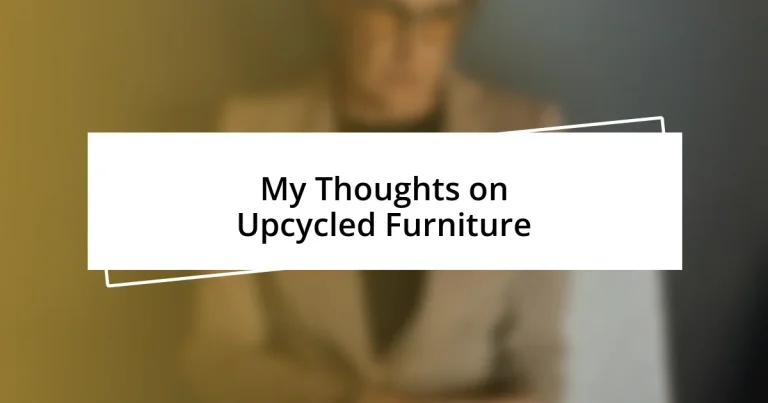Key takeaways:
- Upcycled furniture significantly reduces waste, contributes to sustainability, and adds unique character compared to mass-produced items.
- Choosing the right materials is crucial for durability and aesthetics; reclaimed materials can give furniture a unique narrative.
- Planning, embracing imperfections, and experimenting with techniques are key for successful and rewarding upcycling projects.

Understanding upcycled furniture benefits
One of the most compelling benefits of upcycled furniture is its environmental impact. I remember the first time I transformed an old wooden chair into a colorful garden piece; not only did it reduce waste, but I felt a sense of purpose knowing I contributed to sustainability. Have you ever thought about how much furniture ends up in landfills? Upcycling allows us to breathe new life into discarded items, significantly reducing our carbon footprint.
Moreover, upcycled furniture has a unique character that mass-produced pieces often lack. Each upcycled item tells a story, carrying a piece of history with it. I once found a distressed trunk at a flea market and repurposed it as a coffee table; it instantly became a conversation starter. Isn’t it interesting how a single piece can evoke such memories and spark discussions about style and creativity?
Financially, upcycling can also be a savvy choice. Instead of investing in expensive new furniture, I’ve often discovered that a little creativity and elbow grease can lead to stunning results at a fraction of the cost. Isn’t that something we all can appreciate? Not only does it save money, but it also encourages a more personal connection to the furnishings we choose to live with.

Choosing the right materials
When it comes to choosing the right materials for upcycled furniture, I find that it’s crucial to consider durability and aesthetics. For instance, I once tackled a project using reclaimed barn wood. Not only did it have a rustic charm, but its sturdiness made it a perfect fit for building a shelf that could withstand the test of time. Have you ever thought about how crucial the material’s origin can be in defining the finished product’s character?
I also think about the environmental implications of the materials I select. Recently, I upcycled a set of doors into a dining table. The wood was salvaged from a renovation project, and each scratch and knot added to the table’s unique narrative. It’s fascinating how using reclaimed materials can give furniture a story, connecting past and present in a single piece. The thrill of giving new life to what might have been discarded is incredibly rewarding.
Lastly, I firmly believe that texture plays a key role in the overall aesthetic of upcycled furniture. Combining different materials can evoke emotion and visual interest. I experimented with an old metal bed frame paired with vintage fabric for cushions, and the result was a vibrant bench that transformed a dull hallway into an inviting space. When selecting materials, I always ask myself: how will this piece feel, not just in style but in spirit?
| Material | Pros |
|---|---|
| Reclaimed Wood | Durable, unique character, sustainable |
| Metal | Strong, industrial aesthetic, can be easily painted |
| Fabric (upholstered) | Variety of patterns/colors, adds comfort, versatile |

Techniques for upcycling furniture
When I dive into upcycling furniture, I often find joy in experimenting with various techniques that bring out creativity. One method I particularly adore is painting. I vividly remember transforming a drab, old dresser into a vibrant piece with a fresh coat of bright teal chalk paint. The moment I stepped back and admired my handiwork, I felt a spark of pride; it was like witnessing a metamorphosis. Adding stencils or distressing the paint with sandpaper can elevate the charm, creating a piece that feels more like art and less like furniture.
Here are some techniques I’ve found to be particularly effective in upcycling:
- Decoupage: Using decorative paper or fabric to cover surfaces, creating an eye-catching design.
- Reupholstering: Breathing new life into upholstered furniture by updating the fabric—there’s nothing quite like the feeling of sinking into a chair that looks brand new.
- Modifying Shapes: Sometimes just altering the form of a piece, like cutting down the legs of an old table, can change its purpose entirely. I once took a dated coffee table and fit it with shorter legs to make it a chic pet bed stand.
- Mixing Materials: Combining wood and metal or textiles can produce unique pieces. I fused wooden crates with metal piping to create a rustic bookshelf that turned heads.
- Staining: Giving wood a fresh stain can enhance its natural beauty. I vividly recall using a dark walnut stain on a set of old chairs, which transformed them from forgettable to fabulous.
I find that each technique not only changes the aesthetics but also teaches me patience and sharpens my skills—both of which are incredibly rewarding in their own right.

Transforming old furniture creatively
When I think about transforming old furniture creatively, it’s exciting how even the simplest pieces can become conversation starters. For instance, I remember a time when I inherited a mismatched set of chairs from my grandmother. Instead of letting them sit in storage, I painted each one a different pastel color, adding some funky cushions to match. Not only did this create a cohesive look, but it also brought back fond memories of family gatherings, making those chairs feel like a part of my history.
One of my favorite projects involved an old wooden ladder that I found at a garage sale. I had this vision of turning it into a plant stand, so I sanded it down and applied a weathered finish that brought out its character. As I carefully arranged potted plants on each rung, I realized that I had created more than just a functional item; I had fashioned a piece of art that brightened my living space. Isn’t it incredible how creativity breathes new life into something that was once forgotten?
I also adore the idea of mixing functionality with creativity. I’ve taken an old trunk and turned it into a coffee table by adding a glass top. This not only provided a stunning visual but also offered storage for my books and blankets. Each time I see it, I can’t help but smile, thinking about how something once destined for the dump now serves a purpose in my home. It’s that kind of transformation—turning the mundane into the extraordinary—that fuels my passion for upcycled furniture. Wouldn’t you agree that every creation tells a story waiting to be shared?

Essential tools for upcycling
When gearing up for an upcycling project, having the right tools is essential. I always keep a trusty power drill on hand; it’s a game-changer for assembling or disassembling furniture. I can still recall the excitement of taking apart an old dresser just to transform it into a chic bar cart. That moment of seeing the pieces laid out, ready for a new life, felt like unwrapping potential.
Sanding blocks and electric sanders are also key components in my toolkit. I remember tackling a once-sturdy coffee table that had seen better days. As I sanded away the old finish, I felt this rush of anticipation. It’s amazing how removing those layers can reveal the original beauty of the wood. It’s like peeling back time, and that persistent vibration of the sander in my hands made me feel empowered.
Of course, don’t forget about good-quality paints and brushes! I swear by chalk paint for its versatility and ease of use. One time, I decided to experiment with layering colors and stripes on a vintage dresser. Watching it come to life as I applied each brush stroke made me realize: the right colors can truly tell a story. So, what tools do you find essential for your upcycling adventures? I’d love to hear about your go-to items!

Tips for successful upcycling projects
When embarking on an upcycling project, I believe planning is half the battle. I once took on a vintage side table that was in rough shape, and while I was excited to transform it, I realized that sketching out my vision beforehand saved me a lot of headaches. Have you ever started a project only to find yourself stuck halfway through? My experience taught me that a clear plan makes the process smoother and more enjoyable.
Another tip I’d like to share is to embrace imperfections. I remember the first time I refurbished a worn-out chair; the wood had some dings that I initially wanted to sand out completely. But then I thought, why not highlight those unique features? Those little blemishes became a part of the chair’s charm. Isn’t it fascinating how embracing what we once saw as flaws can lead to something beautifully authentic?
Lastly, don’t underestimate the power of experimentation. I often mix and match techniques, like combining stenciling with decoupage on a small bookshelf I revitalized. Each application felt like a new discovery, and I loved the excitement of trial and error. Have you tried something unconventional in your projects? The thrill of seeing how ideas can merge into something unexpected adds another layer of joy to the upcycling process.














